Abstract
The absorption of fat was studied in five male subjects with cannulation of the thoracic duct in the neck by the administration of doubly labeled monoglycerides, or triglyceride as well as labeled free glycerol or labeled free oleic acid, by gastric or duodenal intubation.
Total recoveries of the administered glyceride radioactivity from the lymph lipids ranged from 35 to 53% for the glycerol label (tritium) and from 35 to 57% for the fatty acid label (14C). The recovery of administered radioactive free glycerol in lymph lipids was only 4.1%, even when given in mixture with bile salts, fatty acid, and monoglyceride.
A comparison of the isotope ratios of the two components (glycerol and fatty acid) of the lymph glycerides with the ratios of these components of the original meal glyceride showed little change during the initial period of fat absorption, indicating that the doubly labeled monoglycerides passed into the lymph intact. During the later part of the period of major fat absorption, the ratios in lymph lipids changed due to loss of glycerol representation, indicating monoglyceride hydrolysis and portal venous diversion of free glycerol.
Confirmation of the intact nature of 2-monoglyceride during absorption was made by analyzing the amount and position of the labeled fatty acid in the lymph triglycerides. The percentage of labeled fatty acid in the various positions of the lymph triglycerides was virtually identical with that of the meal during the initial period of fat absorption and then changed reflecting isomerization of fatty acids and subsequent complete hydrolysis of the glycerides.
The 2-monoglyceride pathway appears to be the major route of fat absorption for man during normal digestion and absorption of dietary triglyceride.
Full text
PDF
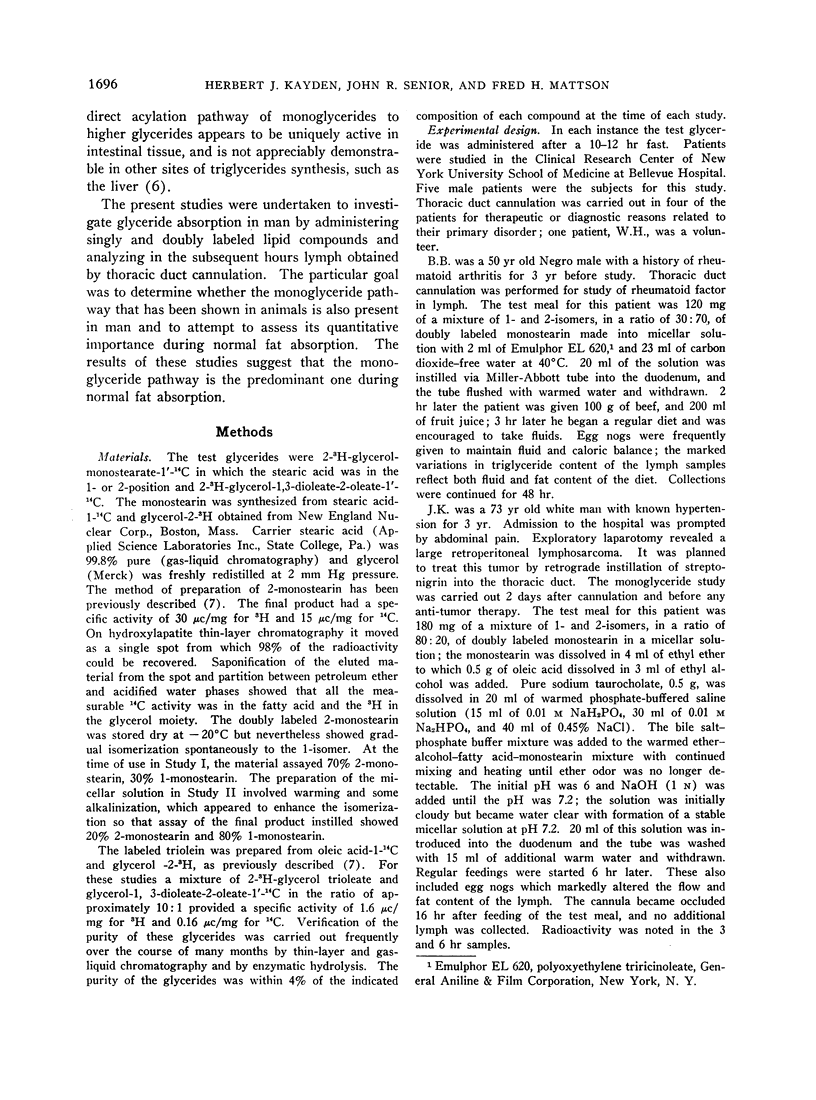
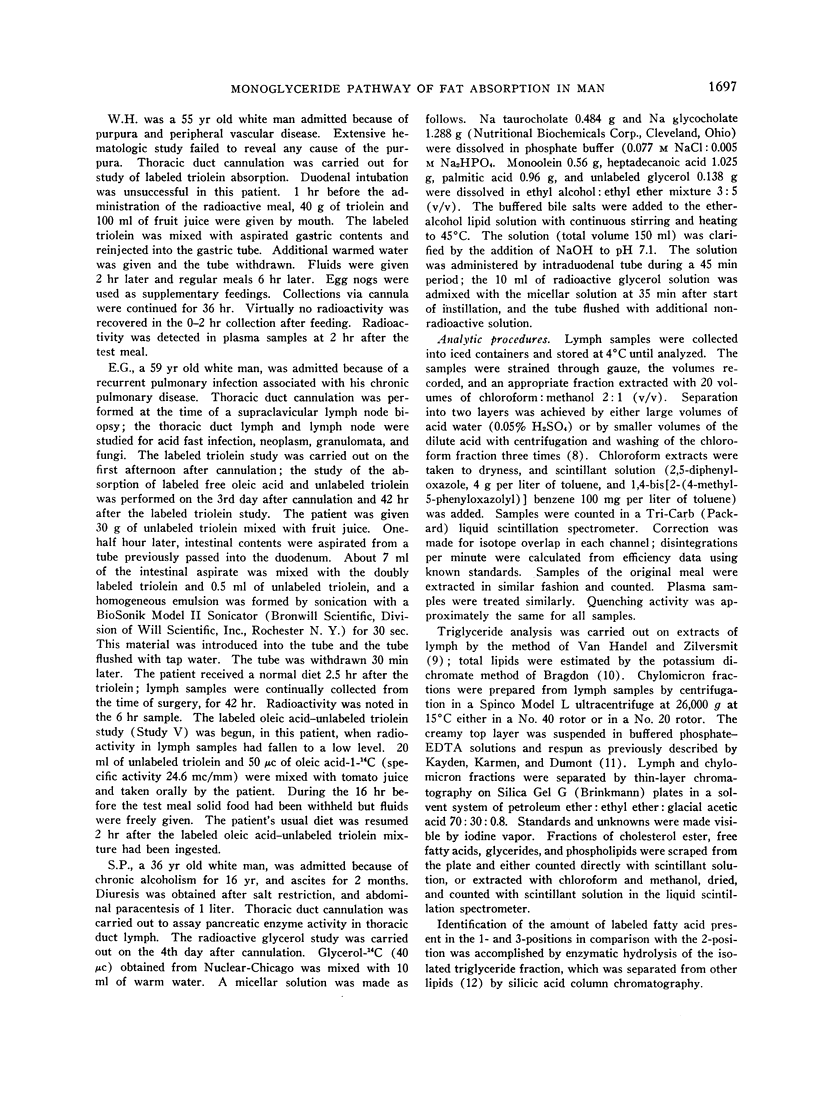


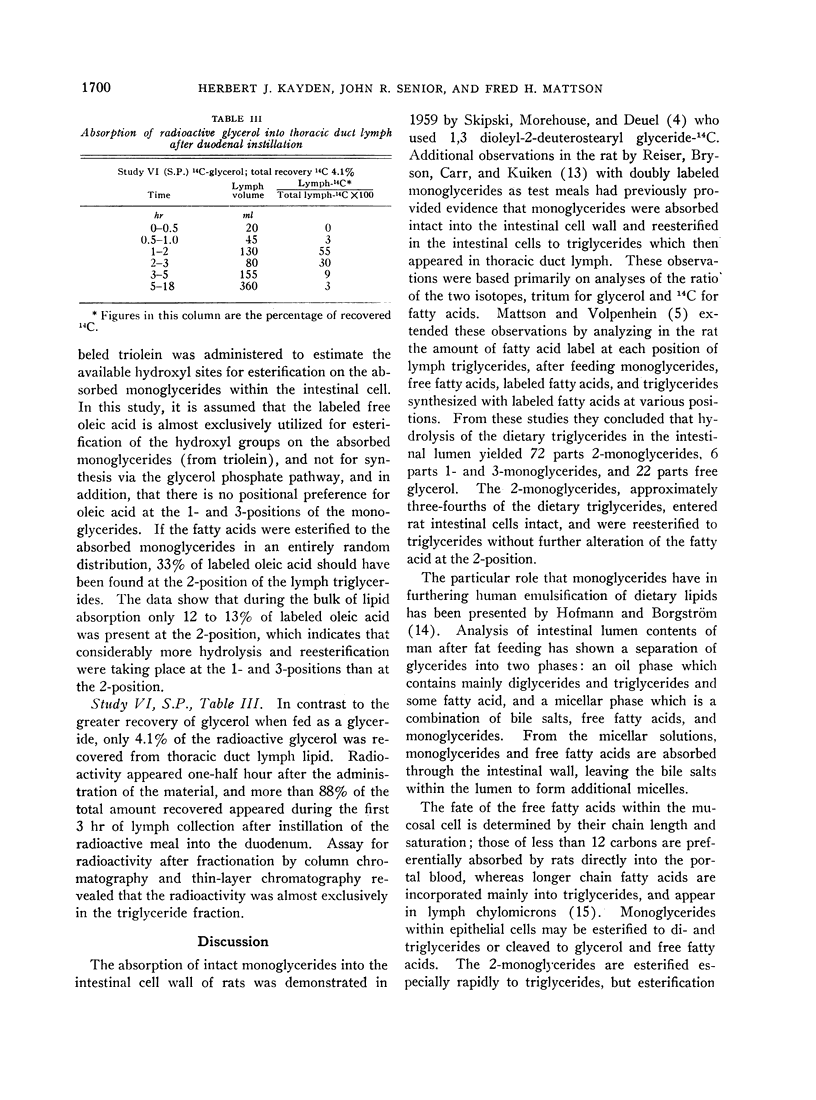
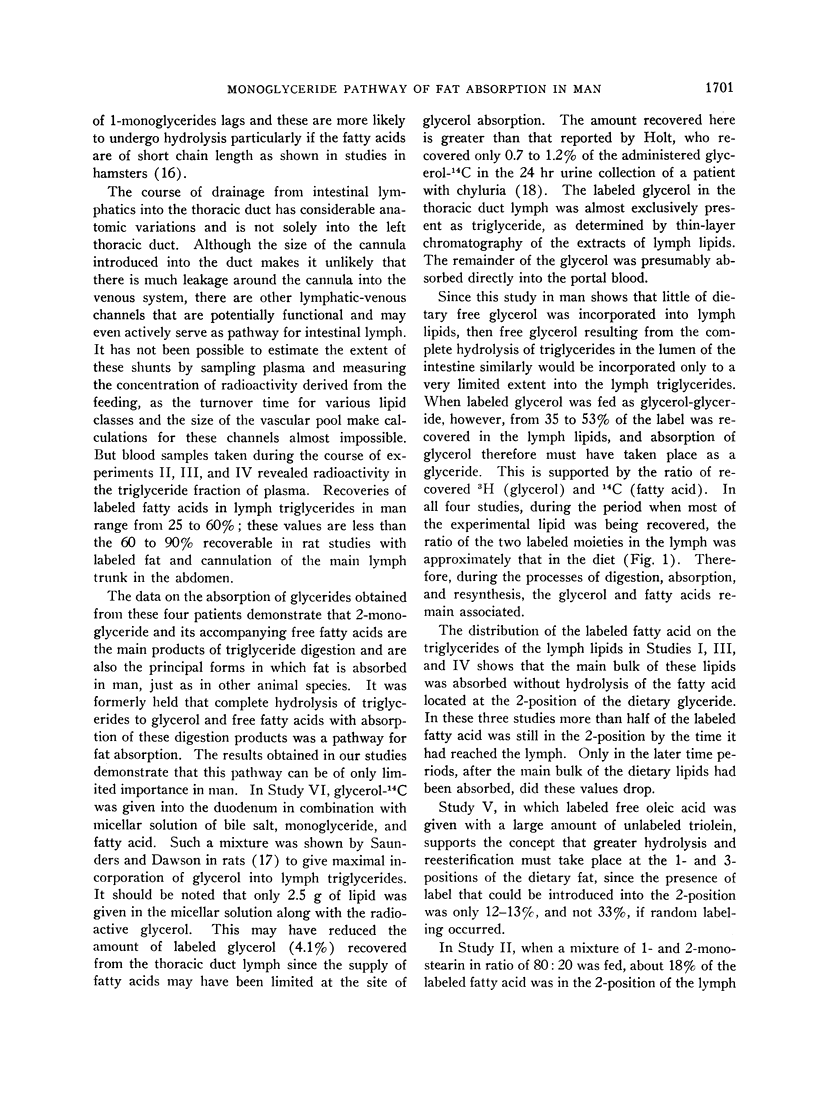
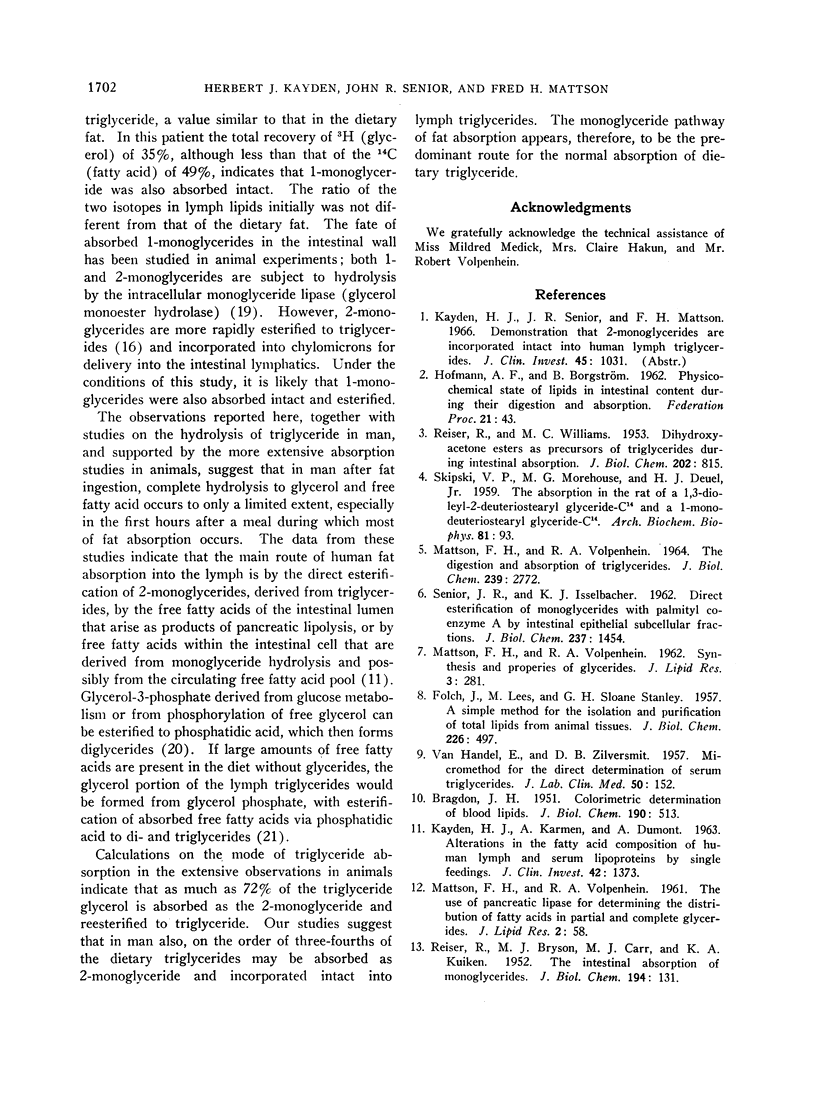
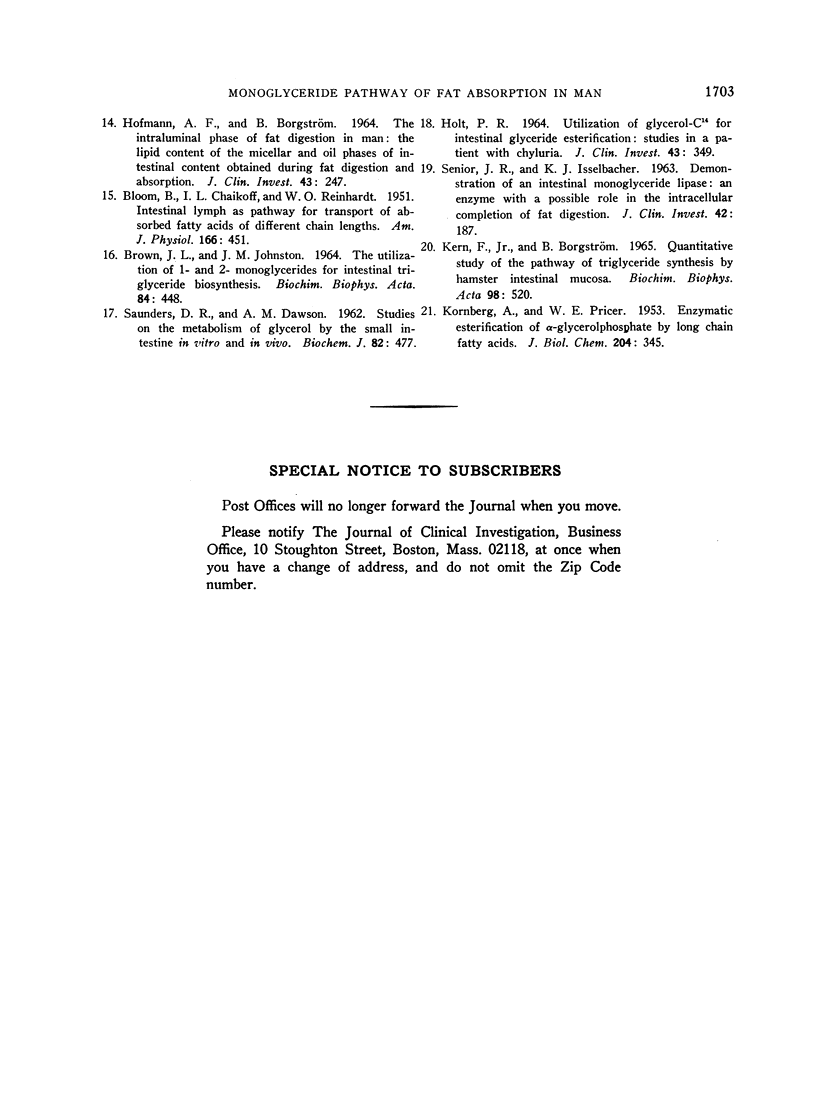
Selected References
These references are in PubMed. This may not be the complete list of references from this article.
- BLOOM B., CHAIKOFF I. L., REINHARDT Intestinal lymph as pathway for transport of absorbed fatty acids of different chain lengths. Am J Physiol. 1951 Aug;166(2):451–455. doi: 10.1152/ajplegacy.1951.166.2.451. [DOI] [PubMed] [Google Scholar]
- BRAGDON J. H. Colorimetric determination of blood lipides. J Biol Chem. 1951 Jun;190(2):513–517. [PubMed] [Google Scholar]
- BROWN J. L., JOHNSTON J. M. THE UTILIZATION OF I- AND 2-MONOGLYCERIDES FOR INTESTINAL TRIGLYCERIDE BIOSYNTHESIS. Biochim Biophys Acta. 1964 Aug 5;84:448–457. doi: 10.1016/0926-6542(64)90009-5. [DOI] [PubMed] [Google Scholar]
- FOLCH J., LEES M., SLOANE STANLEY G. H. A simple method for the isolation and purification of total lipides from animal tissues. J Biol Chem. 1957 May;226(1):497–509. [PubMed] [Google Scholar]
- HOFMANN A. F., BORGSTROM B. Physico-chemical state of lipids in intestinal content during their digestion and absorption. Fed Proc. 1962 Jan-Feb;21:43–50. [PubMed] [Google Scholar]
- HOLT P. R. UTILIZATION OF GLYCEROL-C14 FOR INTESTINAL GLYCERIDE ESTERIFICATION: STUDIES IN A PATIENT WITH CHYLURIA. J Clin Invest. 1964 Mar;43:349–356. doi: 10.1172/JCI104920. [DOI] [PMC free article] [PubMed] [Google Scholar]
- KAYDEN H. J., KARMEN A., DUMONT A. ALTERATIONS IN THE FATTY ACID COMPOSITION OF HUMAN LYMPH AND SERUM LIPOPROTEINS BY SINGLE FEEDINGS. J Clin Invest. 1963 Sep;42:1373–1381. doi: 10.1172/JCI104821. [DOI] [PMC free article] [PubMed] [Google Scholar]
- KORNBERG A., PRICER W. E., Jr Enzymatic esterification of alpha-glycerophosphate by long chain fatty acids. J Biol Chem. 1953 Sep;204(1):345–357. [PubMed] [Google Scholar]
- Kern F., Jr, Borgström B. Quantitative study of the pathways of triglyceride synthesis by hamster intestinal mucosa. Biochim Biophys Acta. 1965 Jun 1;98(3):520–531. doi: 10.1016/0005-2760(65)90148-7. [DOI] [PubMed] [Google Scholar]
- MATTSON F. H., VOLPENHEIN R. A. THE DIGESTION AND ABSORPTION OF TRIGLYCERIDES. J Biol Chem. 1964 Sep;239:2772–2777. [PubMed] [Google Scholar]
- REISER R., BRYSON M. J., CARR M. J., KUIKEN K. A. The intestinal absorption of triglycerides. J Biol Chem. 1952 Jan;194(1):131–138. [PubMed] [Google Scholar]
- REISER R., WILLIAMS M. C. Dihydroxyacetone esters as precursors of triglycerides during intestinal absorption. J Biol Chem. 1953 Jun;202(2):815–819. [PubMed] [Google Scholar]
- SAUNDERS D. R., DAWSON A. M. Studies on the metabolism of glycerol by the small intestine in vitro and in vivo. Biochem J. 1962 Mar;82:477–483. doi: 10.1042/bj0820477. [DOI] [PMC free article] [PubMed] [Google Scholar]
- SENIOR J. R., ISSELBACHER K. J. Demonstration of an intestinal monoglyceride lipase: an enzyme with a possible role in the intracellular completion of fat digestion. J Clin Invest. 1963 Feb;42:187–195. doi: 10.1172/JCI104705. [DOI] [PMC free article] [PubMed] [Google Scholar]
- SENIOR J. R., ISSELBACHER K. J. Direct esterification of monoglycerides with palmityl coenzyme A by intestinal epithelial subcellular fractions. J Biol Chem. 1962 May;237:1454–1459. [PubMed] [Google Scholar]
- SKIPSKI V. P., MOREHOUSE M. G., DEUEL H. J., Jr The absorption in the rat of a 1,3-dioleyl-2-deuteriostearyl glyceride-C14 and a 1-monodeuteriostearyl glyceride-C14. Arch Biochem Biophys. 1959 Mar;81(1):93–104. doi: 10.1016/0003-9861(59)90178-x. [DOI] [PubMed] [Google Scholar]
- VAN HANDEL E., ZILVERSMIT D. B. Micromethod for the direct determination of serum triglycerides. J Lab Clin Med. 1957 Jul;50(1):152–157. [PubMed] [Google Scholar]


